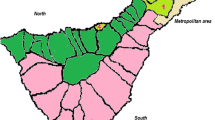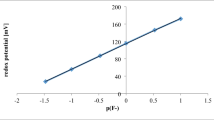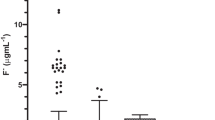Abstract
Tea is the second most commonly consumed beverage in the world. It is well recognized that the consumption of tea in high quantities can promote the development of fluorosis. The main objective of this study is to estimate the exposure to fluoride in the Azores through drinking tea prepared with water from different volcanic locations, by i) investigating the fluoride (F) content of various commercial brands of tea (Camellia sinensis) marketed in Azores and ii) comparing tea releasing rates of F according to brewing time, considering the fluoride concentration in the different types of water used for the infusion. Fluoride contents were determined by ion-selective electrode in 30 samples of drinking water from three different locations and in 450 samples of tea (black and green tea) from three different brands. Fluoride concentration in water ranged from 0.29 to 1.56 ppm (Porto Formoso and Sete Cidades village, respectively). Fluoride concentrations increased with brewing time, reaching the highest values in the Azorean black and green tea infusions. For all the studied brands, a negative correlation was found between tea fluoride contents and the pH of the water used to prepare the infusion. Fluoride concentration in infusions was significantly associated with the background fluoride concentration in drinking water. Since the fluoride concentration in groundwater varies accordingly to the geological conditions and tea consumption can contribute to fluoride intake, it is important to define the limits for tea consumption, particularly in fluoride-rich areas.

Fluoride concentrations in black and green tea for 3 minutes of brewing time and, association between fluoride concentration and pH with brewing time

Similar content being viewed by others
References
European Food Safety Authority (EFSA). 2006. Tolerable upper intake levels for vitamins and minerals. Scientific Committee on Food Scientific Panel on Dietetic Products, Nutrition and Allergies. ISBN: 92–9199–014-0
World Health Organization (WHO) (2006) In: Bailey K, Chilton J, Dahi E, Lennon M, Jackson P, Fawell J (eds) Fluoride in Drinking-water. WHO Press, Geneva.
Hudaykuliyev Y, Tastekin M, Poyrazoglu ES, Baspinar E, Velioglua YS (2005) Variables affecting fluoride in Turkish black tea. Fluoride 38:38–43
Cao J, Luo SF, Liu JW, Li W (2004) Safety evaluation on fluoride content in black tea. Food Chem 88:233–236
Farsam H, Ahmadi N (1978) Fluorine content of teas consumed in Iran. J Food Sci 43:274–275
Schmidt-Hebel H, Pennacchiotti I, Truhaut R, Boudeue C, Jimenez A, Torres E et al (1972) Content of fluorine in some foods and beverages consumed in Chile. Fluoride 5(2):82–84
Cao X, Zhao G, Yin M, Li J (1998) Determination of ultratrace rare earth elements by inductively coupled plasma mass spectroscopy with microwave digestion and AG50W-X8 cation exchange chromatography. Analyst 123:1115–1119
Fung KF, Zhang ZQ, Wong JWC, Wong MH (1999) Fluoride contents in tea and soil from tea plantations and the release of fluoride into tea liquor during infusion. Environ Pollut 104(2):197–205(9)
World health Organization (WHO) (1984) Fluorine and Fluorides. In: Environmental Health Criteria, Series 36, 25–26, Geneva
Bilbeissi MW, Fraysse C, Mitre D, Kerebel LM, Kerebel B (1988) Dental fluorosis in relation to tea drinking in Jordan. Fluoride Qual Rep 21(3):121–126
Cao J, Bai X, Zhao Y, Liu J, Zhou D, Fang S, Jia M, Wu J (1996) The relationship of fluorosis and brick tea drinking in Chinese Tibetans. Environ Health Perspect 104(12):1340–1343
Whyte MP, Essmyer K, Gannon FH, Reinus WR (2005) Skeletal fluorosis and instant tea. Am J Med 118(1):78–82
Baptista J, Lima E, Paiva L, Andrade AL, Alves MG (2012) Comparison of Azorean tea Theanine to teas from other origins by HPLC/DAD/FD. Effect of fermentation, drying temperature, drying time and shoot maturity. Food Chem 132:2181–2187
Searle R (1980) Tectonic pattern of the Azores spreading Centre and triple junction. Earth Planet Sci Lett 51:415–434
Cordeiro S, Coutinho R, Cruz JV (2012) Fluoride content in drinking water supply in São Miguel volcanic island (Azores, Portugal). Sci Total Environ 432:23–36
Vivona R, Preziosi E, Madé B, Giuliano G (2007) Occurrence of minor toxic elements in volcanic-sedimentary aquifers: a case study in Central Italy. Hydrogeol J 15:1183–1196
Rango T, Bianchini G, Beccaluva L, Ayenew T, Colombani N (2009) Hydrogeochemical study in the main Ethiopian rift: new insights to the source and enrichment mechanism of fluoride. Environ Geol 58:109–118
Cronin SJ, Sharp DS (2002) Environmental impacts on health from continuous volcanic activity at Yasur (Tanna) and Ambrym, Vanuatu, international. J Environ Health Res 12:109–123
Cronin SJ, Neall VE, Lecointre JA, Hedley MJ, Loganathan P (2003) Environmental hazards of fluoride in volcanic ash: a case study from Ruapehu volcano, New Zealand. J Volcanol Geotherm Res 121:271–291
Weinstein P (2005) Palaeopathology by proxy: the case of Egil’s bones. J Archaeol Sci 32:1077–1082
Lobo M (1993) Contribuição para o estudo físico-químico e microbiológico da água para consumo humano do arquipélago dos Açores. Universidade dos Açores, Departamento de Ciências Agrárias
Baxter P, Baubron J, Coutinho R (1999) Health hazards and disaster potential of ground gas emissions at Furnas volcano, São Miguel, Azores. J Volcanol Geotherm Res 92:95–106
Linhares D, Garcia P, Amaral L, Ferreira T, Cury J, Vieira W et al (2016) Sensitivity of two biomarkers for biomonitoring exposure to fluoride in children and women: a study in a volcanic area. Chemosphere 155:614–620
World Health Organization (WHO) (2004) Guidelines for drinking-water quality: recommendations, 3.ed edn, Geneva
National Institute for Occupational Safety and Health (NIOSH) (1984) Fluoride in urine. In: Manual of Analytical Methods, vol. 11, pp. 8308–1–8308-3, US Department of Health and Human Services, 3rd edition
Buck P, Rondinini S, Covington AK, Baucke FGK, Brent CMA, Camoes MF et al (2009) Measurement of pH. Definition, standards, and procedures (IUPAC recommendations 2002). Pure Appl Chem 74(11):2169–2200
Paiva SM, Lima YBO, Cury JA (2003) Fluoride intake by Brazilian children from two communities with fluoridated water. Community Dent Oral Epidemiol 31:184–191
IBM SPSS 20.0 (2011) IBM SPSS Statistics 20 Core System User’s Guide, USA
Council Directive 98/83/EC of 3 November of 1998 on the quality of water intended for human consumption
Gupta P, Sandesh N (2012) Estimation of fluoride concentration in tea infusions, prepared from different forms of tea, commercially available in Mathura city. J Int Soc Prev Commun Dent 2(2):64–68
Cao J, Zhou Y, Liu JW (1998b) Safety evaluation and fluoride concentration of Pu’er brick tea and Bianxiao brick tea. Food Chem Toxicol 36:1061–1063
Lung SCC, Hsiao PK, Chiang KM (2003) Fluoride concentrations in three types of commercially packed tea drinks in Taiwan. J Expo Anal Environ Epidemiol 13:66–73
Gulati P, Singh V, Gupta MK, Vaidya V, Dass S, Prakash S (1993) Studies on the leaching of fluoride in tea infusions. Sci Total Environ 138:213–222
Soil Survey Staff (2014) Keys to soil taxonomy, 12th edn. USDA Natural Resources Conservation Service, Washington, DC
Symonds RB, Rose WI, Reed MH (1988) Contribution of Cl− and F− bearing gases to the atmosphere by volcanoes. Nature 334:415–418
Parker DR, Norvell WA, Chaney RL (1995) GEOCHEM-PC: a chemical speciation program for IBM and compatible personal computers. In: Loeppert RH (ed) Chemical equilibrium and reaction models. Madison, American Society of Agronomy, pp 253–269
Stevens DP, McLaughlin MJ, Alston AM (1998) Phytotoxicity of the fluoride ion and its uptake from solution culture by Avena sativa and Lycopersicon esculentum. Plant Soil 200:119–129
Pandey KB, Rizvi SI (2009) Plant polyphenols as dietary antioxidants in human health and disease. Oxidative Med Cell Longev 2(5):270–278
Malinowska E, Inkielewicz I, Czarnowski W, Szefer P (2008) Assessment of fluoride concentration and daily intake by human from tea and herbal infusions. Food Chem Toxicol 46:1055–1061
Maleki A, Abulmohammadi P, Teymouri P, Zandi S, Daraei H, Mahvi AH et al (2016) Effects of brewing time and water hardness on fluoride release from different Iranian teas. Fluoride 49(3 Pt 1):263–273
Yadav AK, Kaushilk CP, Haritash AM, Singh B, Raghunvanshi SP, Kansal A (2007) Determination of exposure and probable ingestion of fluoride through tea, toothpaste, tobacco and pan masala. J Hazard Mater 142:77–80
Burt BA (1992) The changing patterns of systemic fluoride intake. J Dent Res 71:1228–1237
Acknowledgements
Diana Linhares was supported by PhD fellowships from the Fundo Regional da Ciência (Regional Government of the Azores) (PROEMPREGO Programme) (M3.1.2/F/019/2011), and Leslie Amaral was supported by Estagiar-L fellowship from Direcção Regional do Emprego e Qualificação Profissional. The authors also thank the financial support of the BioAir-Biomonitoring air pollution: development of an integrated system (M2.1.2/F/00872011) from Fundo Regional da Ciência (Regional Government of the Azores) (PROEMPREGO Programme).
Author information
Authors and Affiliations
Corresponding author
Electronic supplementary material
Online resource 1
(DOC 34 kb)
Rights and permissions
About this article
Cite this article
Linhares, D.P.S., Garcia, P.V., Amaral, L. et al. Safety Evaluation of Fluoride Content in Tea Infusions Consumed in the Azores—a Volcanic Region with Water Springs naturally Enriched in Fluoride. Biol Trace Elem Res 179, 158–164 (2017). https://doi.org/10.1007/s12011-017-0947-9
Received:
Accepted:
Published:
Issue Date:
DOI: https://doi.org/10.1007/s12011-017-0947-9




